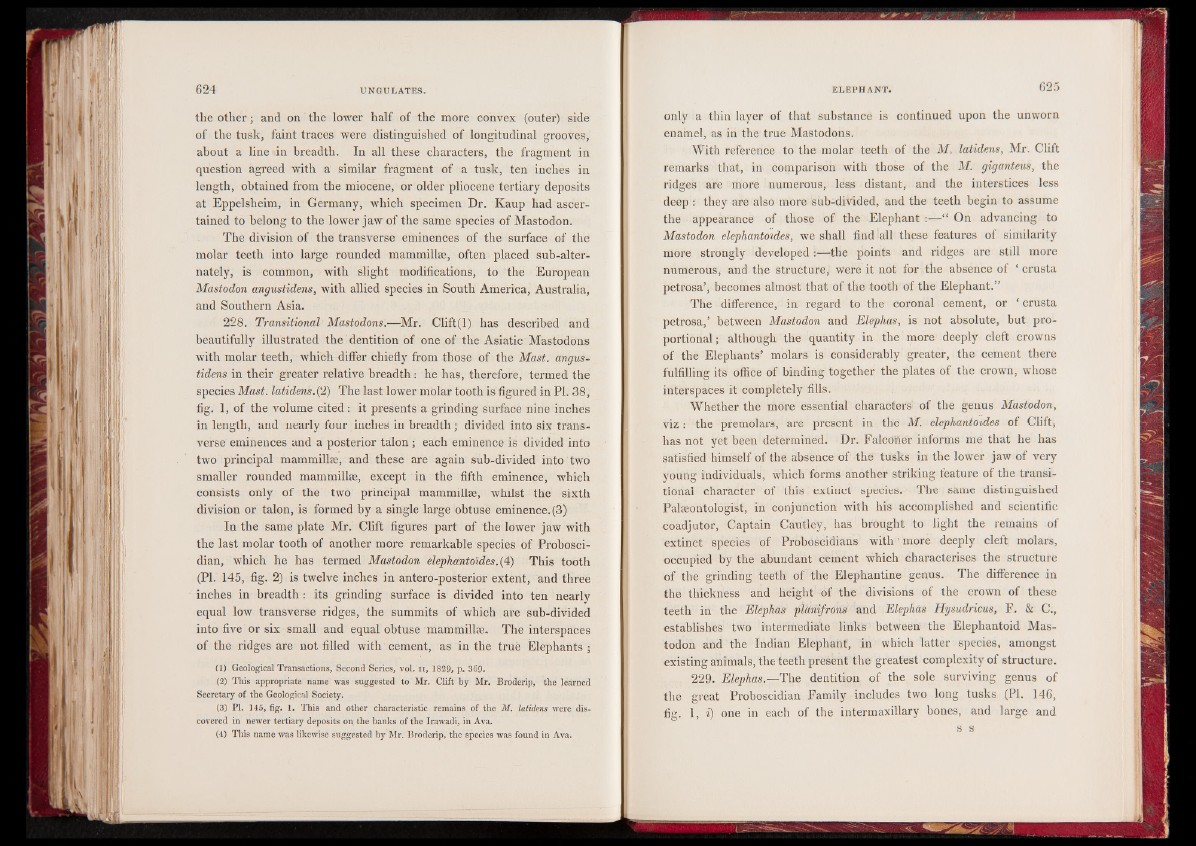
the other; and on the lower half of the more convex (outer) side
of the tusk, faint traces were distinguished of longitudinal grooves,
about a line in breadth. In all these characters, the fragment in
question agreed with a similar fragment of a tusk, ten inches in
length, obtained from the miocene, or older pliocene tertiary deposits
at Eppelsheim, in Germany, which specimen Dr. Kaup had ascertained
to belong to the lower jaw of the same species of Mastodon.
The division of the transverse eminences of the surface of the
molar teeth into large rounded mammillae, often placed sub-alter-
nately, is common, with slight modifications, to the European
Mastodon angustidens, with allied species in South America, Australia,
and Southern Asia.
228. Transitional Mastodons.—Mr. Clift(l) has described and
beautifully illustrated the dentition of one of the Asiatic Mastodons
with molar teeth, which differ chiefly from those of the Mast, angustidens
in their greater relative breadth: he has, therefore, termed the
species Mast. latidens. (2) The last lower molar tooth is figured in PI. 38,
fig. 1 , of the volume cited : it presents a grinding surface nine inches
in length, and nearly four inches in breadth; divided into six transverse
eminences and a posterior talon ; each eminence is divided into
two principal mammillae, and these are again sub-divided into two
smaller rounded mammillae, except in the fifth eminence, which
consists only of the two principal mammillae, whilst the sixth
division or talon, is formed by a single large obtuse eminence. (3)
In the same plate Mr. Clift figures part of the lower jaw with
the last molar tooth of another more remarkable species of Proboscidian,
which he has termed Mastodon elephantoides.{4) This tooth
(PI. 145, fig. 2) is twelve inches in antero-posterior extent, and three
inches in breadth : its grinding surface is divided into ten nearly
equal low transverse ridges, the summits of which are sub-divided
into five or six small and equal obtuse mammillae. The interspaces
of the ridges are not filled with cement, as in the true Elephants ;
(1) Geological Transactions,' Second Series, vol. n , 1829, p. 369.
(2) This appropriate name was suggested to Mr. Clift by Mr. Broderip, the learned
Secretary of the Geological Society.
(3) PI. 145, fig. 1. This and other characteristic remains of the M. latidens were discovered
in newer tertiary deposits on the hanks of the Irawadi, in Ava.
(4) Tliis name was likewise suggested by Mr. Broderip, the species was found in Ava.
only a thin layer of that substance is continued upon the unworn
enamel, as in the true Mastodons.
With reference to the molar teeth of the M. latidens, Mr. Clift
remarks that, in comparison with those of the M. giganteus, the
ridges are more numerous, less distant, and the interstices less
deep : they are also more sub-divided, and the teeth begin to assume
the appearance of those of the Elephant :—“ On advancing to
Mastodon elephantoides, we shall find all these features of similarity
more strongly developed:—the points and ridges are still more
numerous, and the structure, were it not for the absence of ‘ crusta
petrosa’, becomes almost that of the tooth of the Elephant.”
The difference, in regard to the coronal cement, or ‘ crusta
petrosa,’ between Mastodon and Elephas, is not absolute, but proportional;
although the quantity in the more deeply cleft crowns
of the Elephants’ molars is considerably greater, the cement there
fulfilling its office of binding together the plates of the crown, whose
interspaces it completely fills.
Whether the more essential characters of the genus Mastodon,
viz : the premolars, are present in the M. elephantoides of Clift,
has not yet been determined. Dr. Falconer informs me that he has
satisfied himself of the absence of the tusks in the lower jaw of very
young individuals, which forms another striking feature of the transitional
character of this extinct species. The same distinguished
Palaeontologist, in conjunction with his accomplished and scientific
coadjutor, Captain Cautley, has brought to light the remains of
extinct species of Proboscidians with' more deeply cleft molars,
occupied by the abundant cement which characterises the structure
of the grinding teeth of the Elephantine genus. The difference in
the thickness and height of the divisions of the crown of these
teeth in the Elephas pletnifrons and Elephas Hysudricus, F. & C.,
establishes two intermediate links between the Elephantoid Mastodon
and the Indian Elephant’, in which latter species, amongst
existing animals, the teeth present the greatest complexity of structure.
229. Elephas.—The dentition of the sole surviving genus of
the great Proboscidian Family includes two long tusks (PI. 146,
fig. 1, i) one in each of the intermaxillary hones, and large and
s s